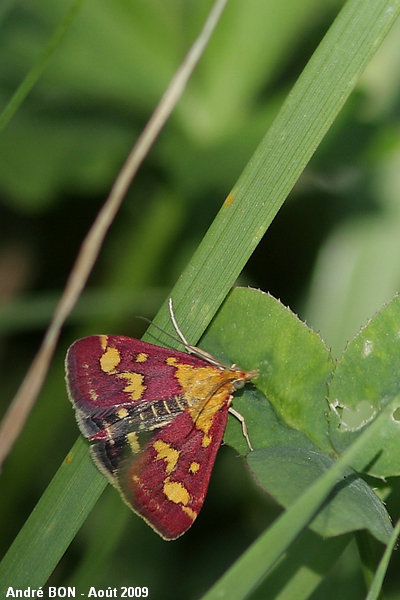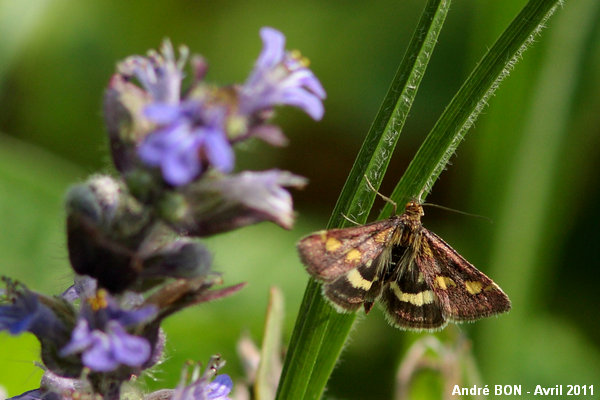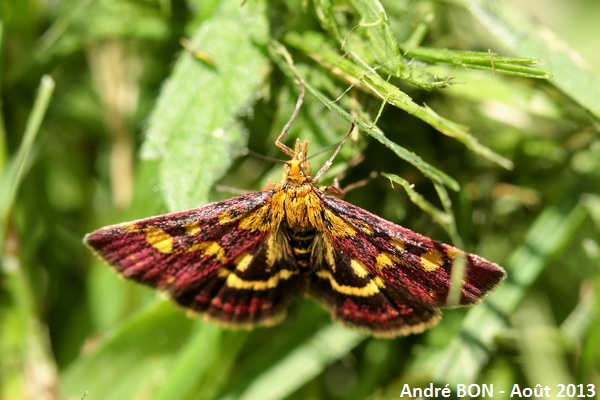


| Pyrausta purpuralis (Linnaeus, 1758) |



|
|
Scientific name: Pyrausta purpuralis (Linnaeus, 1758) Common name: French name: Pyrale pourpre Order: Lepidoptera Suborder: Heterocera Family: Crambidae Subfamily: Pyraustinae Wingspan: 18-20 mm. Biotope: Damp meadows, hedgerows, woodland edges, forest paths with flowers. Geographic area: Europe, Africa, Asia. Flight time: May to June, then July to September. Number of generations : 2 Caterpillar: The larva hides inside a shelter made up with two attached leaves on the host plant. Host plant: Various Mint family plants like Corn Mint (Mentha arvensis) and Thyme (Thymus). |
Pyrausta purpuralis shows dark purple fore wings. This beautiful colour turns to brown with age. The basal area of the fore wings is a bright golden yellow colour. There are a few golden yellow spots in the costal area but the most noticeable is an alignment of post median golden patches (a small triangular patch next to the costal edge, a large rounded patch at the centre and a dented and curved patch next to the inner margin). All these patches make an almost continuous stripe. The hind wings are darker and show a pale and thin post median stripe. There is a white spot in the basal area. The abdomen is dark purple and ringed with pale lines. The most similar species are the Mint Moth (Pyrausta aurata) and Pyrausta ostrinalis. The Mint Moth differs by the alignment of post median patches, on the fore wing, which is missing or more fragmented next to the inner edge. All these patches do not give the look of a post median stripe. The post median stripe on the hind wings is also broader on Pyrausta aurata. There is no white discal spot. It is slightly more difficult to tell Pyrausta purpuralis apart from Pyrausta ostrinalis. The post median stripe on the upper side of the fore wings is thinner and less interrupted in separate patches on Pyrausta ostrinalis. A view of the under side of the fore wings enables to remove any doubt. Pyrausta purpuralis shows a thin and straight subterminal line which fades away before reaching the costal edge. This subterminal line is broader on Pyrausta ostrinalis, it is curved towards the post median stripe near the costal edge. Pyrausta purpuralis flies both during the day and during the night. The larvae of the second brood over winter in a cocoon under the soil. |
| [To know more about the Pyrausta purpuralis] [Next picture] [Top] |

|
Pyrausta purpuralis is really a very beautiful moth. I would have liked to shoot a picture in a nicer environment. You can see the typical shape of the three patches forming the post median stripe. |
| [To know more about the Pyrausta purpuralis] [Next picture] [Previous picture] [Top] |

|
This moth has been kind to open its fore wings so that we can see a large part of its hind wings. The presence of a pale spot in the basal area enables to discard Pyrausta aurata. The post median stripe, made of three well separated patches, indicates Pyrausta purpuralis |
| [To know more about the Pyrausta purpuralis] [Previous picture] [Top] |

|
The angle of view is still not perfect but the identification criteria of the species are well visible on this picture. |